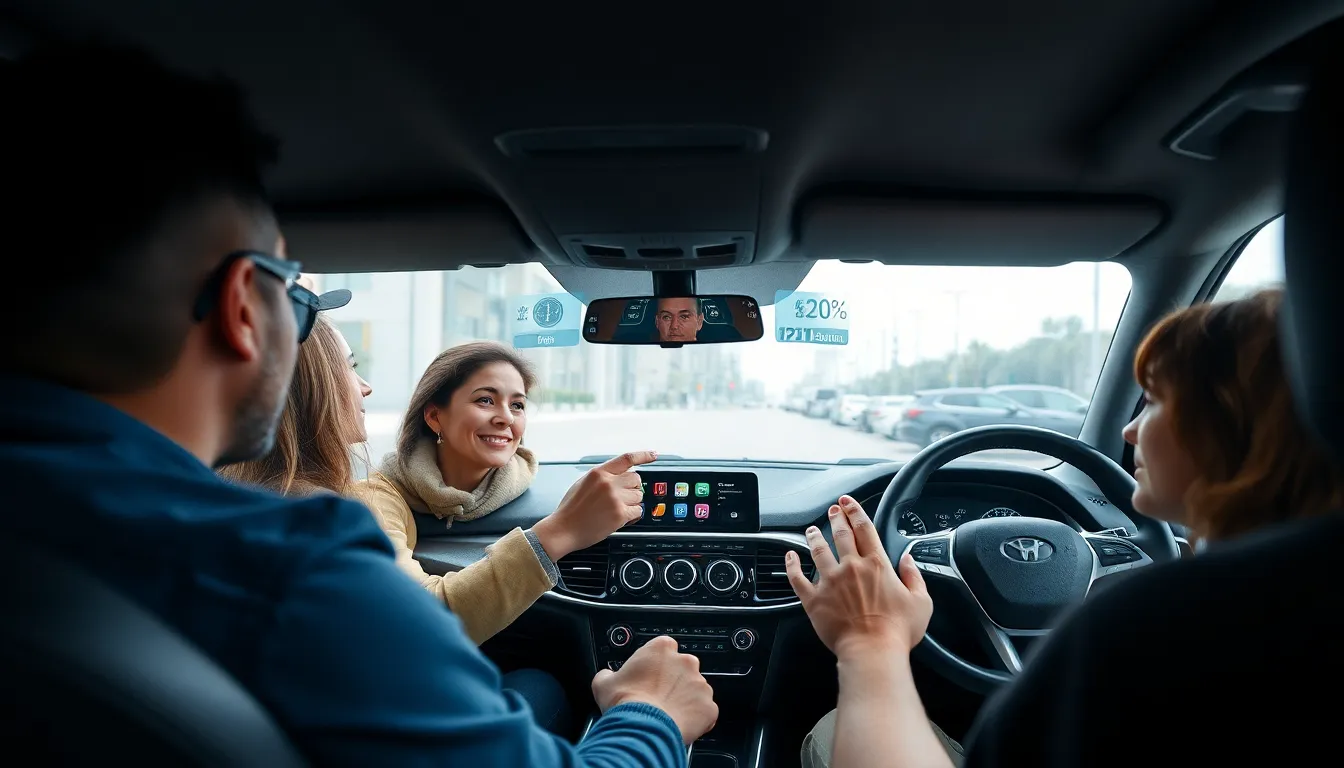In a world where technology rules and patience is a rare virtue, HUD responsiveness stands out as a game-changer. Imagine a user interface that adapts to your every whim faster than a cat chasing a laser pointer. That’s the magic of HUD responsiveness. It’s not just about looking good; it’s about delivering an experience that keeps users coming back for more.
Table of Contents
ToggleOverview of HUD Responsiveness
HUD responsiveness involves the ability of a Heads-Up Display to adapt quickly to users. It affects how users interact with technology. A responsive HUD presents information clearly and efficiently, enhancing the user’s ability to make decisions in real-time.
Users benefit from minimal latency in feedback, ensuring that operations function as expected. For example, quick updates on navigation or vital system stats keep users informed during critical tasks. Performance metrics indicate that a highly responsive HUD can increase user satisfaction and retention rates significantly.
Designing for responsiveness requires understanding user behaviors. Surfaces should accommodate various inputs, including touch and voice commands. Responsiveness also intersects with usability. An interface that reacts instantly to user commands encourages exploration and boosts engagement.
Industry standards suggest that a response time of less than 50 milliseconds optimally enhances user engagement. Achieving this standard may involve robust testing of interactions and optimizing graphical elements.
Incorporating adaptive features allows HUDs to serve diverse contexts. For instance, in automotive applications, a HUD can display pertinent data based on driving conditions, improving safety.
User feedback plays a critical role in refining HUD responsiveness. Regular updates based on user suggestions lead to incremental improvements, enhancing overall functionality. By prioritizing responsiveness, technology developers can foster a more interactive experience, ultimately encouraging prolonged use and loyalty.
Importance of HUD Responsiveness

HUD responsiveness significantly influences user interaction with technology. A highly responsive HUD ensures that users can access information swiftly, adapting seamlessly to their needs.
User Experience Considerations
User experience plays a vital role in HUD design. Systems that respond quickly to inputs allow users to interact smoothly, reducing frustrations that arise from delays. Enhanced response times lead to higher engagement levels. Users appreciate intuitive interfaces and immediate feedback, especially in critical scenarios like driving. Designers should prioritize creating HUDs that facilitate effortless navigation, supporting different input methods. Furthermore, understanding user behavior helps developers optimize interactions, ensuring that every touch, swipe, or voice command translates into prompt responses.
Impacts on Accessibility
Accessibility remains a crucial aspect of HUD responsiveness. Systems need to accommodate diverse user abilities, offering tailored adjustments for different needs. A responsive HUD can present information clearly for individuals with visual impairments, using audio prompts or tactile feedback. Effective designs ensure that all users can access vital information regardless of their circumstances. Supporting various input methods enhances usability, empowering users with disabilities to interact confidently. Developers focusing on accessibility not only comply with regulations but also broaden their user base, fostering inclusivity in technology use.
Factors Influencing HUD Responsiveness
HUD responsiveness depends on various factors that contribute to the user experience. These factors include design elements and technical specifications, both of which play significant roles in creating effective HUD systems.
Design Elements
User interface design affects HUD responsiveness significantly. The layout must prioritize clarity and ease of navigation. Creating intuitive graphical elements ensures users can interact without confusion. Aesthetic choices should not overshadow functionality. Colors and fonts must enhance readability in diverse lighting conditions. Additionally, incorporating adaptive designs caters to various contexts, improving the overall user experience. Ensuring feedback mechanisms, such as touch and visual cues, respond instantly enhances engagement during interaction.
Technical Specifications
Technical specifications dictate the performance of HUD systems. Optimal response times aim for less than 50 milliseconds for engaging user experiences. Device processing power impacts how smoothly a HUD operates. High refresh rates improve visual continuity and responsiveness to user inputs. Moreover, software algorithms should prioritize low latency to facilitate real-time decisions. Supporting multiple input methods, such as voice commands and touch gestures, is essential for versatile application. Regularly updating software and hardware components keeps the system aligned with advancing technologies, meeting user expectations effectively.
Evaluation of HUD Responsiveness
Evaluating HUD responsiveness involves examining various metrics that indicate performance and user satisfaction.
Performance Metrics
Key performance indicators shed light on HUD efficiency. Response time is often measured in milliseconds, with optimal times under 50 milliseconds essential for user engagement. Additionally, latency during high-stakes tasks greatly influences decision-making speeds. Enhanced user satisfaction often links to lower latency feedback. Studies show that a HUD with minimal lag can elevate retention rates significantly. These metrics are crucial in assessing how effectively a HUD responds to user inputs and preferences.
User Feedback and Surveys
User feedback plays a vital role in refining HUD responsiveness. Conducting regular surveys helps gather insights into real-world experiences. Feedback identifies pain points and areas for improvement, providing valuable data for designers. Consistently updating interfaces based on user suggestions fosters a more intuitive experience. Furthermore, understanding user needs leads to more adaptive features that enhance overall usability. Developers utilizing this feedback can prioritize adjustments, ensuring the HUD remains efficient and user-friendly.
Future Trends in HUD Responsiveness
Emerging technologies are shaping the future of HUD responsiveness. AI integration enhances personalization, adapting to user behaviors and preferences. Natural language processing enables HUDs to understand voice commands more efficiently, streamlining user interactions. Machine learning algorithms learn from past user actions, ensuring increasingly accurate responses over time.
Advancements in AR and VR are also significant. These technologies offer immersive experiences, allowing HUDs to overlay critical information in real-time environments. For example, in automotive applications, navigation information can appear seamlessly on the windshield, improving safety and focusing user attention.
Cloud computing enhances HUD capabilities by providing vast processing power. This approach allows systems to handle large data sets quickly, decreasing response times while offering real-time updates. Utilizing data analytics ensures that HUDs present the most relevant information, tailored to each user’s needs.
Greater emphasis on inclusivity drives design choices. Future HUDs prioritize accessibility features, offering customizable interfaces for users with diverse abilities. Designers incorporate audio prompts, haptic feedback, and adjustable text sizes, ensuring everyone accesses essential information.
Sustainability influences technology development trends. HUDs built with energy-efficient components reduce overall environmental impact, aligning with modern eco-friendly objectives. Developers focus on optimizing performance while conserving resources, enabling systems to function efficiently.
Regular updates and improvements will remain critical for HUD systems. Continuous software enhancements based on user feedback ensure that interfaces evolve alongside technology advancements. Building an adaptive HUD infrastructure creates a user-centric approach, positioning these systems at the forefront of technological innovation.
HUD responsiveness is essential for enhancing user experience in a technology-driven world. By prioritizing quick and efficient interactions designers can significantly boost user satisfaction and retention. The focus on functionality over aesthetics ensures that users can make informed decisions with minimal latency.
As technology continues to evolve integrating AI and other advancements will shape the future of HUDs. Accessibility remains a key consideration enabling all users to benefit from responsive systems. Continuous updates and refinements based on user feedback will keep HUDs aligned with changing needs and expectations.
Ultimately a well-designed responsive HUD not only enhances engagement but also fosters inclusivity and sustainability in technology use.




